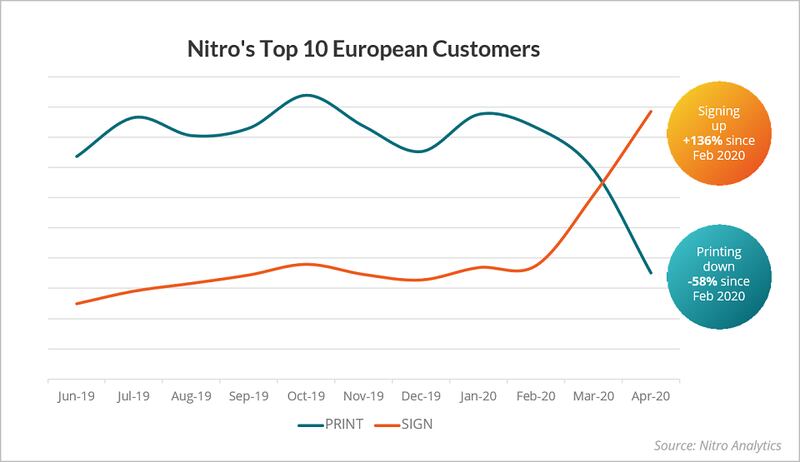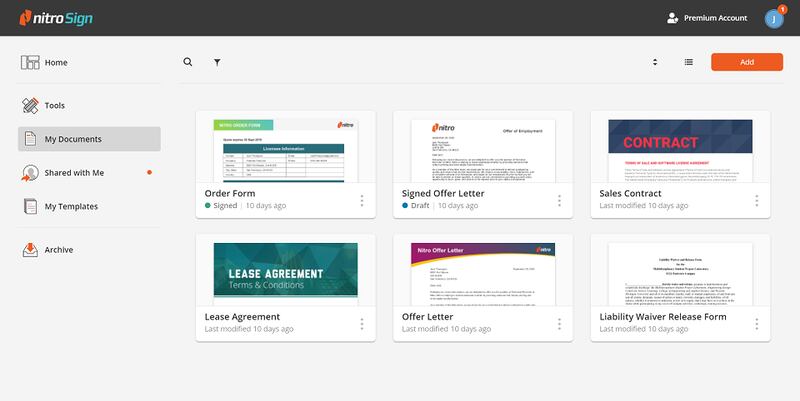In an effort to ensure the safety and wellbeing of employees, customers, and partners during the coronavirus pandemic, businesses around the globe have been forced to switch to a remote work environment - in some cases, from zero to 100 per cent, in just a matter of days.
Now as lockdowns begin to ease and the economy reopens, what will the future of work look like? Based on extensive research conducted via Nitro Analytics, we have no doubt that remote work will become the new norm.
A preview of the workplace post Covid-19
The concept of remote work is not new, especially with the advancement in digital collaboration technologies in the last few years. But until Covid-19, paper-based processes were still a part of daily office life, as noted in our Nitro 2020 Productivity Report.
With more people now accustomed to working from home, online-only workflows have become a new standard (and expected, too).
As more companies and individuals realise the tangible benefits of digitisation, it’s very unlikely that things will revert back to the way they were. Remote work opens up new possibilities for both employers and employees, and ultimately offers the opportunity to get creative building the optimal work environment of the future.
The acceleration of business performance
Since the onset of Covid-19, we’ve witnessed an urgent migration from paper to digital processes. Research from Nitro Analytics across our global user base from February to April 2020 shows:
- 67 per cent increase in digital annotation and collaboration
- 108 per cent increase in electronic signature requests (136 per cent increase among our top 10 European customers)
- 92 per cent increase in digital form filling
- 61 per cent increase in digital signing
- 52 per cent decrease in global printing (58 per cent decrease among our top 10 European customers)

As a result of this digital document transformation, there has been an astounding 43 per cent faster signature turnaround time on documents. This means staff can work more efficiently and securely on vital documents (such as contracts, invoices, and SOWs) that help to keep important business workflows afloat, and in many cases making them much easier.
Gerard Ding, head of Information Technology ANZ at JLL, says: “With many of our staff not having printers at home, we’ve seen a marked shift in terms of their increased use of digital tools - and electronic signatures in particular - in order to help maintain business continuity and optimise efficiencies in this new way of working.”
A remote workforce also frees up funds normally associated with operating a physical office space. Expenses such as rent, utilities, insurance, and catering can be redirected into other areas that will drive both business growth and employee productivity and satisfaction.
An expectation of flexibility for employees
With stay-at-home orders in place, standard domestic challenges (such as distance learning for school-age children and more household chores) have disrupted the traditional workday. While juggling multiple responsibilities is a challenge, many employees are enjoying an improved work/life balance.
In fact, new research conducted by Nitro in May 2020 among knowledge workers globally shows that 73 per cent anticipate working from home as much, or more frequently, after Covid-19. And, 67 per cent say that working-from-home policies are very or extremely important when considering future opportunities.
The optimisation of productivity
Skipping a daily commute to big cities like Dublin (which already has one of the highest commute times in the EU) means that employees can use hours in the day more meaningfully. Stress levels associated with traffic or public transport go down, too. A culmination of these factors often leads to happier and more engaged employees, with better performance results and lower turnover.
Setting up your remote workforce for success
With the ability to move faster than ever before, businesses are going to continue collaborating online and replacing paper-based processes with digital capabilities. But while there’s no longer a need for printers, scanners, paper, and pens, there have been other challenges.
With the rush to move to remote working to mitigate Covid-19, many businesses have experienced a general lack of preparedness. Employees don’t always have an ideal setup at home, for example.
To prosper in the future of work, a company’s top priority should be to ensure standardisation and optimal productivity - from physical desks and chairs, laptops, monitors, high-speed internet, and access to all tools required for employees to excel in their roles.
Enter the age of online tools
Evidence shows that it’s unlikely work will simply return to how it was before. Even coming out of Covid-19, there are:
- new constraints (such as social distancing)
- costly considerations (such as extensive sanitisation routines)
- employee expectations (such as the ability to work anywhere, anytime).
Wherever “work” takes place in the future, how it gets done will need to be digital-first. Every employee will need to be equipped with virtual tools. Every document workflow will need to be streamlined and 100 per cent online. Gone are the days of slowing business down just because someone needs to get something printed and signed manually.
How Nitro Sign can help
As a global document productivity company, Nitro offers products designed to enable working from anywhere with documents digitally including PDF editing and electronic signature solutions.
Gina O’Reilly, COO of Nitro, says: “We moved to 100 per cent remote early in the pandemic, and we are anticipating a staggered return to the offices in some capacity before the end of the year. However, firm plans around the future are still in progress, and we are seeing this as an opportunity:
- to embrace remote work as an operating principle
- to innovate around the best ways to optimise for both business productivity and our employees' personal situations and preferences
- to ultimately leverage having a distributed team with a flexible work policy into a significant competitive advantage."
Gina continues: “We’re looking forward to what we believe is an exciting evolution of the modern work environment, and we’re on a mission to help make the transition easier for businesses during these challenging times.”
Use Nitro Sign for free through 2020
To help businesses prepare for the future of work, Nitro is offering a new standalone electronic signature solution, Nitro Sign, which provides unlimited, enterprise-grade eSigning capabilities for individuals and businesses of all sizes to get documents signed smarter, faster, more securely - from anywhere. It is currently available for free through to the end of 2020.
[ Sign up for free eSigning software today.Opens in new window ]












